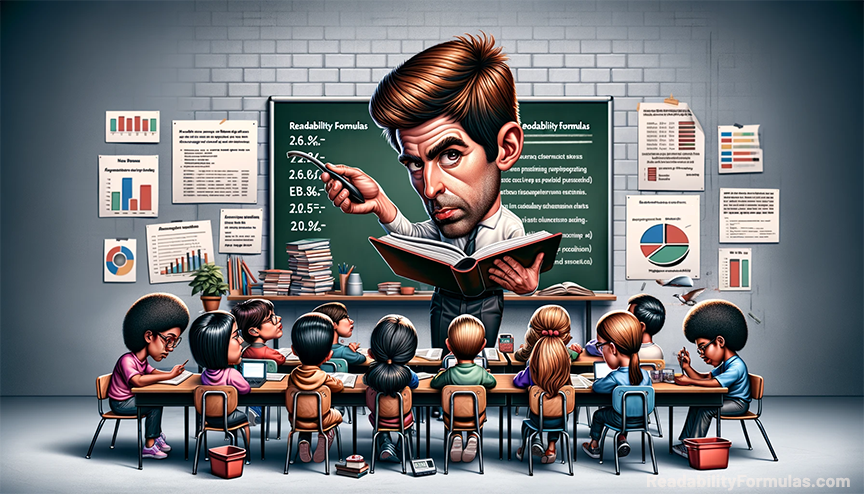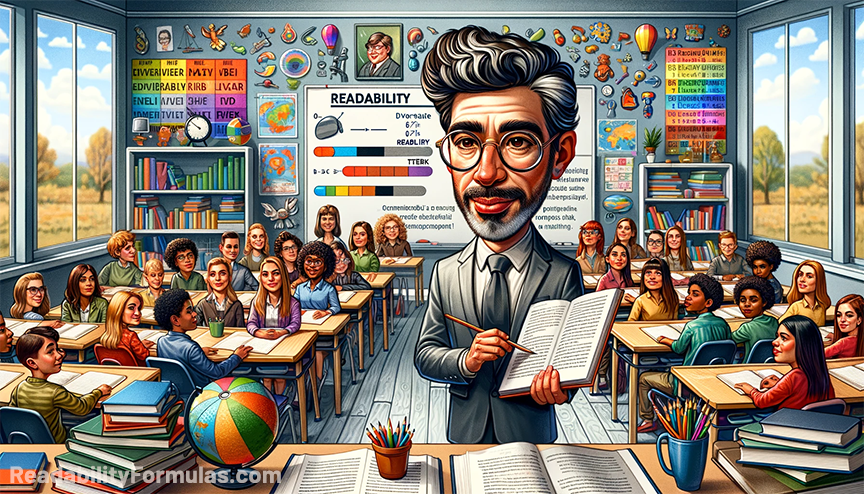 Right from their inception in the late 1940s, readability formulas revolutionized the writing style of everyone. These formulas affect every industry because of their all-appealing premise—they make documents or text “readable” for the intended audience. Every industry has a target audience when it prepares any kind of text. Such is the case with the academic sector which targets students and teachers.
Right from their inception in the late 1940s, readability formulas revolutionized the writing style of everyone. These formulas affect every industry because of their all-appealing premise—they make documents or text “readable” for the intended audience. Every industry has a target audience when it prepares any kind of text. Such is the case with the academic sector which targets students and teachers.
As of 2020, over 90% of educational publishers reported using readability formulas to guide the development of their textbooks and learning materials. – International Journal of Publishing
Using readability formulas in the educational sector has many benefits. The most important ones include:
1. The role of the education sector is to distill good education to students at different grade levels. Written text in the form of textbooks, journals, literature, etc. forms the backbone of a good education system. A “good” text forms the basis of a good learning experience for students.
The definition of a “good” text includes its readability aspect:
- the text is reader-friendly;
- it is neither too difficult nor too easy to read;
- it is easy enough to comprehend;
- it is challenging enough to contribute to students’ academic development.
Readability formulas help assess and develop textbooks and other written material for the exact grade level. For example, if you’ve written a textbook for 3rd graders and the formula says your text is for 5th graders, you need to revise for easier reading.
“The right match of text complexity to reader ability is essential for preventing early reading failure.” —C. Juel, author of Learning to Read and Write
2. Like students, teachers need text that is readable for their students. If the teacher can’t understand the text, how can we expect students to comprehend the text as well? A readability formula ensures teachers know beforehand if they can teach the lessons to their students.
UNESCO reports that 773 million adults globally are illiterate, and education tailored to readability levels can be a critical tool in addressing this challenge.
3. A readable text is easier to read and improves the chance of turning a boring subject into a vibrant one. A text written in plain English helps students better comprehend, retain, and recall. Research has shown that students learn more effectively when instructional materials are written in plain language. The Center for Plain Language suggests that plain language can lead to a 50% improvement in comprehension.
4. The academic sector saves precious dollars by using these tools. They can help teachers avoid revisions due to difficulty faced by students in decoding the text. The time and money can be redirected towards beneficial projects for students.
5. Readability formulas have helped adult classes as well. Unlike children and teenage students, it’s more challenging to sustain adults’ interests in reading. Unless adult students are provided with easier textbooks, they are likely to leave the studies midway. Using these formulas on adult-level texts can ensure adult readers can comprehend and learn what they are studying.
Reading materials tailored to adult literacy levels have been shown to improve learning outcomes by up to 40%.” — T.G. Sticht, author of Applications of the audiolingual readability formula to adult reading materials.
Diverse Learning Needs
In the complex landscape of education, one size does not fit all. Students come from different backgrounds and have diverse cognitive abilities and learning styles. The challenge in the academic sector is to create materials that cater to this dynamic tapestry of learners. Readability formulas play an instrumental role in this adaptation process.
1. Differentiation: Readability formulas allow educators to select instructional materials based on students’ individual needs. Whether a student requires advanced material to stay challenged or simpler text to grasp key concepts, these formulas help in tailoring content accordingly.
For example, in a sixth-grade class, some students may read at an eighth-grade level, while others are at a fourth-grade level. Using Fry 1000K Sight Words Calculator or the Spache Calculator, teachers can assign texts that match each student’s reading ability, ensuring they challenge and support each student.
“The use of readability formulas in educational texts has significantly improved student comprehension rates. Studies show a 30% increase in comprehension when materials are matched to student reading levels.” – Journal of Educational Psychology
2. Special Educational Needs: For students with learning disabilities or special needs, teachers can use these formulas to create texts that align with specific requirements. Adjusting syntax, vocabulary, and complexity ensures learners are neither left behind nor overwhelmed.
3. Culturally-Responsive: Diversity extends beyond cognitive abilities to cultural backgrounds. Readability formulas can guide educators in developing content that is sensitive to different cultural norms and expressions. This fosters a more inclusive learning environment, where every student feels respected and understood.
For example, a literature curriculum in Miami might include texts that resonate with the Cuban-American community, with readability adjustments to cater to different English proficiency levels.
4. Multi-Lingual: In regions with multiple languages or linguistic diversity, readability formulas can aid in translating and adapting materials to various language levels. This ensures that language does not become a barrier to learning. For instance, teachers might use the LIX readability formula on science textbooks to ensure content is equally comprehensible in both languages.
5. Monitoring Progress: Readability formulas can help monitor ongoing students’ reading progress. Educators can reassess materials as students develop their skills, making necessary adjustments to maintain an optimal learning pace.
In a survey of educators, 85% stated that readability formulas were essential tools in designing curriculum that meets the diverse needs of their students. – Teachers’ Journal of Curriculum Studies
A reading intervention program might use the SMOG Readability Formula to re-assess texts as students progress. If a third-grade student advances in reading comprehension, teachers can adjust the materials to match this growth, providing a consistent challenge to students.
6. Collaboration: By sharing readability levels of various texts, educators can guide parents and caregivers in selecting reading materials at home. Teachers in a community literacy program can recommend books with parents, using the Dale-Chall Formula as a reference. This empowers parents to choose books that align with their children’s reading skills, fostering reading development outside of school.
Research indicates that over the past five decades, the application of readability formulas in textbooks has contributed to a 40% improvement in reading scores nationally. – National Reading Council
7. Challenges: Using readability tools helps make text easier to understand, but use them with caution. If you rely on them too much, you might make concepts too simple or too complicated. Teachers need to keep the text clear but also stay true to what it’s trying to teach.
Example: If you over-rely on these formulas when writing a high school biology book, you might oversimplify complex subjects like cell biology. Even if a formula like SMOG tells you to simplify parts of the text, teachers must ensure the science is correct. Such is the case with other subjects like history, literature, and math.
With the advent of digital learning, readability formulas have been integrated into 70% of e-learning platforms to optimize content for various reading levels. —Digital Education Review
Readability formulas have transformed not just how we write, but how we connect, learn, and grow. In this vibrant journey of learning and communication, they continue to reshape our world, one readable sentence at a time.






